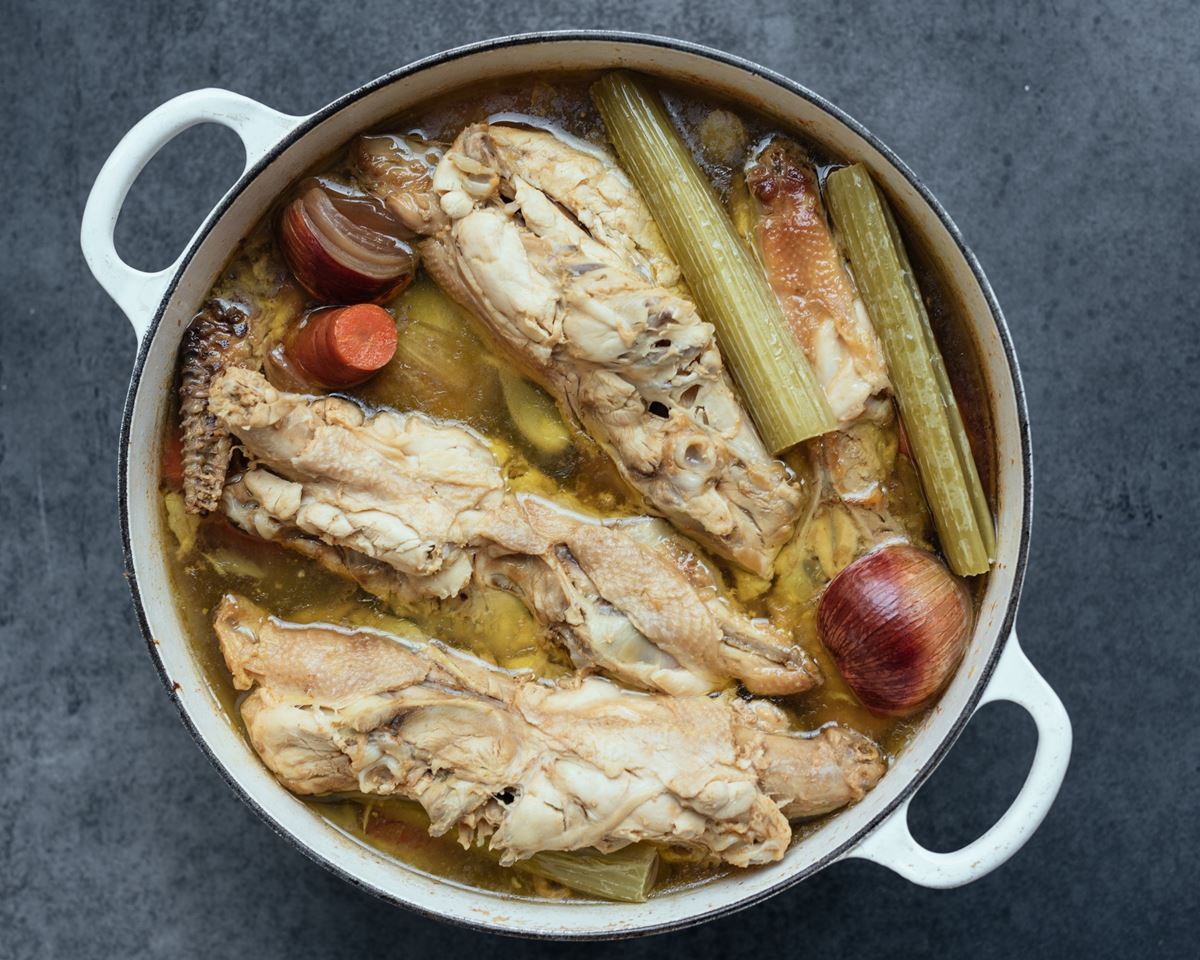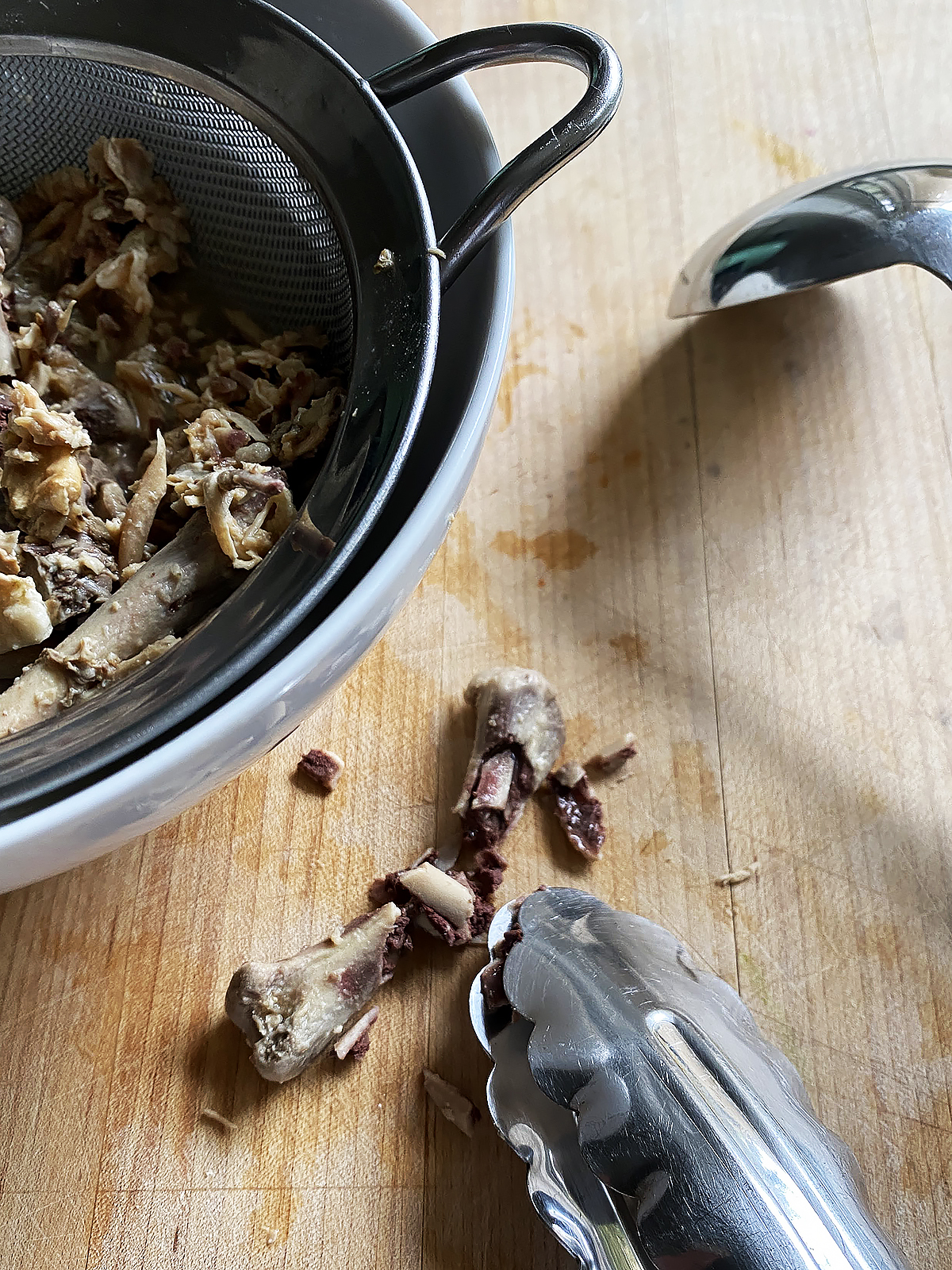Ever stood over a pot wondering “how long do I boil chicken bones for broth?” You’re not alone! Making chicken bone broth is both an art and science that requires patience to extract all those wonderful nutrients and flavors. I’ve made countless batches over the years, and I’m excited to share everything I’ve learned about creating this nutritional powerhouse in your own kitchen.
The Perfect Timing for Chicken Bone Broth
The short answer: For optimal flavor and nutrition, simmer chicken bones for 8-24 hours on the stovetop, 12-18 hours in a slow cooker, or 2-3 hours in a pressure cooker.
But there’s much more to it than just time! Let’s dive deeper into making the perfect bone broth.
What’s the Difference: Broth vs. Stock vs. Bone Broth
Before we get into timing, let’s clarify what we’re making:
-
Chicken Broth Made mostly from meat with some bones simmered for 1-2 hours. Results in a light-colored mild-flavored liquid that doesn’t gel.
-
Chicken Stock: Made primarily from bones with bits of meat and skin, simmered longer. Darker, richer flavor than broth.
-
Bone Broth: Despite having “broth” in the name, this is more like an intense stock. Simmered extra-long until bones become soft enough to crumble between your fingers. Rich in collagen (which makes it gel when cooled).
Why Simmering Time Matters
The magic of bone broth happens during that long, slow simmer. Here’s what’s happening
- Collagen extraction: The longer you simmer, the more collagen gets released from joints, cartilage, and marrow
- Mineral release: Apple cider vinegar helps draw calcium, magnesium, and other minerals from the bones
- Flavor development: Complex flavors develop as proteins break down
Simmering Times by Cooking Method
Stovetop Method (8-24 hours)
This traditional approach gives you the most control over temperature and lets you monitor the process easily.
- Place bones in a large pot with apple cider vinegar and cover with cold water
- Bring to a boil, then immediately reduce to the lowest possible simmer
- Let simmer gently for 8-24 hours, adding vegetables in the last hour
- Strain and cool
Slow Cooker Method (12-18 hours)
Perfect for the “set it and forget it” approach, especially if you’re nervous about leaving a stove on.
- Add bones, apple cider vinegar, and cold water to slow cooker
- Set on low for 12-18 hours, adding vegetables in the last 2 hours
- Strain and cool
Pressure Cooker/Instant Pot Method (2-3 hours)
For when you need bone broth in a hurry!
- Add bones, apple cider vinegar, and cold water to pressure cooker
- Cook on high pressure for 2-3 hours
- Allow for natural pressure release
- Strain and cool
While pressure cooking is faster, some folks believe it doesn’t extract quite as much flavor and nutrients as the longer methods. I’ve found it works great in a pinch though!
What You’ll Need for Amazing Bone Broth
Essential Ingredients:
- Chicken bones (2+ pounds)
- Apple cider vinegar (1 tablespoon)
- Cold filtered water
- Salt (optional)
Optional Flavor Boosters:
- Onions, carrots, celery (add in last hour or two)
- Garlic
- Bay leaves, thyme, parsley
- Mushrooms for extra umami
- Ginger and turmeric for warming properties
Pro Tip: The Best Bones to Use
Not all chicken bones are created equal! For the richest, most gelatinous broth:
- Chicken feet: These might look weird, but they’re LOADED with collagen
- Necks and backs: Excellent cartilage-to-bone ratio
- Wing tips: Great for collagen
- Leftover roast chicken carcass: Waste not, want not!
I always keep a “bone bag” in my freezer where I collect chicken bones after meals. Once it’s full, it’s broth-making time!
How to Know When Your Broth is Done
Your broth is ready when:
- It has a rich golden-brown color
- The bones are soft enough to crumble when pressed
- It has a deep, savory aroma
- When chilled, it forms a jiggly gel (sign of high collagen content)
Common Questions About Boiling Chicken Bones
Can I boil chicken bones too long?
Yes! Beyond 24 hours, the broth can develop bitter or off flavors. Taste test periodically after the 8-hour mark.
Should I skim the foam off the top?
Definitely. The foam or “scum” that rises to the surface contains impurities. Skimming results in a clearer, cleaner-tasting broth.
Can I reuse chicken bones for another batch?
While technically possible, a second batch will be significantly weaker. Most folks discard bones after one use when they’ve given up most of their goodness.
How do I know if my broth has enough collagen?
The ultimate test is whether it gels when chilled. If your broth jiggles like jello after refrigeration, congratulations—you’ve extracted plenty of collagen!
My broth is cloudy. Did I do something wrong?
Cloudiness happens when you boil rather than simmer the broth. While not harmful, a gentle simmer produces a clearer broth. You can also strain through a coffee filter for extra clarity.
Storage Tips for Your Liquid Gold
After all that work, make sure to store your broth properly:
- Cool broth quickly in an ice bath (don’t put hot broth directly in fridge)
- Refrigerate for up to 5 days or freeze for up to 3 months
- For easy portioning, freeze in ice cube trays or muffin tins
- Mason jars work great for freezing (leave 1.5 inches headspace for expansion)
A layer of fat may form on top of refrigerated broth—this is normal and actually helps preserve it. You can remove or keep it based on preference.
My Favorite Ways to Use Chicken Bone Broth
Now that you’ve made this nutritional powerhouse, here’s how to enjoy it:
- Sip it straight from a mug with a pinch of salt
- Use as a base for soups and stews
- Cook grains in it instead of water
- Use in sauces and gravies
- Add to mashed potatoes for extra flavor
Health Benefits Worth the Wait
The long simmer time extracts nutrients that make bone broth especially beneficial:
- Collagen and gelatin: Support for joints, skin, and digestive health
- Amino acids: Building blocks for proteins in your body
- Minerals: Including calcium, magnesium, and phosphorus
- Gut-healing properties: May help “seal” the gut lining
Final Thoughts
Making bone broth is one of those slow, nurturing kitchen projects that connects us to traditional cooking methods. The patience required for the long simmer time rewards you with something store-bought versions simply can’t match—deep flavor and maximum nutrition.
Remember, the exact time to boil chicken bones for broth depends on your equipment and preference, but the sweet spot is generally 8-24 hours. Trust your senses—when the broth smells amazing, has a rich color, and the bones are starting to fall apart, you’ve done it right!

What Kind of Bones Do You Use for Bone Broth
You will need a few pounds of chicken bones for this recipe. There are different kinds of bones you can use. Use any or a combination of the below:
- Roast Chicken Leftover Carcass. I almost always make Chicken Bone Broth with leftover bones from roast chicken rather than starting with a whole fresh chicken. Just collect and save the leftover bones in an airtight container in the freezer until you have the time to make the broth. Add the bones directly from the freezer without thawing first. This is a GREAT way to get added value from a store-bought rotisserie chicken!
- Fresh/Raw Chicken Bones. You can use fresh/raw chicken. Remove the meat to use for something else, and use the bones. You can add the fresh bones directly to the pot.
- Wings, neck, and back. All the little bits of bones that you might normally throw away before roasting a chicken, dont. Save them, then throw them into the pot (its ok if theyre not roasted) with the roasted leftover bones. Wings and backbone actually contribute quite a bit of collagen.
Bone Broth: Ultra Rich, Long-Simmered Liquid Gold
Confusingly containing the word “broth,” Bone Broth is actually more like a stock, and when its called “bone broth,” we consider it a liquid that has simmered for longer than plain stock to extract as much collagen, glucosamine, and amino acids out of the bones, which end up becoming soft enough to crumble apart between your fingers.
Bone broth gels in the refrigerator from all the collagen.
Bone broth is what were going for here, and I use it for everything from an immune-boosting sipping bone broth to the base of any soup or stew.

